| Pages:
1
..
3
4
5
6
7
..
9 |
Dan Vizine
National Hazard
   
Posts: 628
Registered: 4-4-2014
Location: Tonawanda, New York
Member Is Offline
Mood: High Resistance
|
|
careysub, I tend to see it like Pok does. For this project, radioactivity is only incidental, just another hazard to be worked around. The thrust of
this project is really meant to be about using metal reagents to prepare other pure metals by thermochemical means.
Damn, that procedure was harder than I had hoped. It took a full hour of hard work with a nice, clean rasp to reduce my 99.9% Ca ingots to silvery
filings stored under UHP argon. This is about 25 grams. At least this represents most of what I'll need.
Now...it's time to travel again. Next week is going to be spent in Atlanta, GA. Work, not fun. Anyway, further experimental progress will just have to
wait.
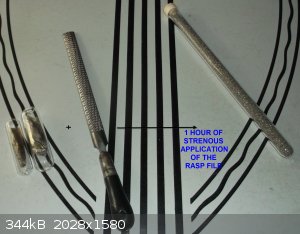
[Edited on 13-9-2014 by Dan Vizine]
|
|
|
Dan Vizine
National Hazard
   
Posts: 628
Registered: 4-4-2014
Location: Tonawanda, New York
Member Is Offline
Mood: High Resistance
|
|
I've tried as much as possible to obtain my reactants in small particle sizes.
One reduction oriented paper (attached) mentions occasional low yields thought to arise from poor blending. Small wonder, I guess, given the
significantly different natures of the reactants, a very fine powder of fairly low density, a coarser powder of much denser material and relatively
large particles of a light-weight metal.
At temperature, the Ca and CaCl2 will be liquid. But, if any coarser, denser thoria settles in a layer above the still denser thorium metal below it,
it may fail to react throughout its thickness. That may explain the possible mechanism and it concerns me.
I had planned agitation all along but my "means" were DOA. Then, I figured I'd do it by hand for the 1 hour reaction period (usually specified).
However, I noticed that the worker's method that I am following specifies soaking at temperature for 5 hours. Too long for effective (even if
intermittent) agitation by hand. I need something that will rotate the reactor back and forth around its long axis.
If the pipe suspending the reactor is constrained to only move through a limited angle around the long axis, say ~ 90 degrees, and a spring holds it
at one end of the allowed range, then a device which pushes the pipe to cause it to rotate through a small angle before releasing it to be returned to
its originally spring-dictated position will achieve what I need.
I dug out this old unit which may serve the purpose. It's a bastard hybrid made from part of an hplc pump and a large old printer motor. It gives a
slow, adjustable rotation to operate the "pusher" mechanism.
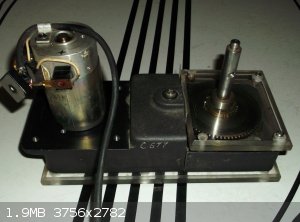
Attachment: Production of Thorium Powder by Calcium Reduction of Thorium Oxide.pdf (159kB)
This file has been downloaded 617 times
|
|
|
Dan Vizine
National Hazard
   
Posts: 628
Registered: 4-4-2014
Location: Tonawanda, New York
Member Is Offline
Mood: High Resistance
|
|
Well, the apparatus is nearly done. I need to set up a suckback-proof mercury bubbler with a mercury depth of 5 inches, set up an argon line from the
basement, dry the finely ground CaCl2, leak-test the reactor and ancillary piping, make a head for the reactor tube that will deliver argon well down
inside the tube (just above the reactor) and I think that's it.
I tried out the agitation system. It makes a little noise, but it's not too bad. It works exactly as I hoped in would. The speed of the pusher motor
is Variac controlled. Depending on my day job's demands, I hope to do the reaction in October.
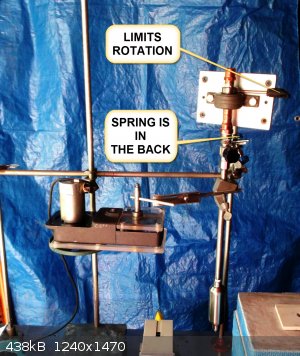
|
|
|
Dan Vizine
National Hazard
   
Posts: 628
Registered: 4-4-2014
Location: Tonawanda, New York
Member Is Offline
Mood: High Resistance
|
|
Some things I've been finding....
Robert Alvarez, Institute for Policy Studies, February 2014
The surface dose rate from a 55 gallon drum of thorium oxide is approximately 60 mR/hr--about 13 times higher than from a similar-sized drum of
uranium. A worker spending time inside a thorium storage facility could expect to encounter dose rates of 60–100 mR/hr. In a little over six working
days, such an employee could reach the maximum annual U.S. occupational exposure limit of 5 rem.
--Just further reassurance that the risk is managed.
Interim Report on Metallurgy of Thorium and Thorium Alloys, Co n t r a c t No. W-7405, eng-26 by J. H. Frye, J r . , Director ORNL Metallurgy
Division-Declassified
Westinghouse Thorium - The. starting material for Westinghouse thorium is thorium oxide. The oxide is reduced with calcium, the reduction being
carried out in a steel crucible in a steel bomb. The crucible is llned with molybdenum so the calcium will not teact with the steel at high
temperatures. The charge is thoria with an excess of 100% calcium placed in alternate layes in the crucible. The bomb assembly, with an argon
atmosphere, is placed in a furnace at 1200° C. When the reaction is complete, the bomb is slow-cooled and not opened until the temperature falls
below 100° C because of the high reactivity of thorium with oxygen. The charge and crucible are placed in a leaching tank of cold wate and glacial
acetic acid equivalent to the total amount of calcium charged. The powder is filtered, washed with alcohol, and vacuum dried. The powder is then
compacted a pressures varying frdm 2-10 tons per square inch. The bars are slowly heated to 1450° C in vacuum and sintered at temperature for 30 min.
--Just something else to fret about......SS304 + Ca @ 1050 C, will that be an issue? Guess I need to do a bit more research on the ability of the
metal to resist the hot Ca. Generally speaking, the more nickel, the worse the metal is for containing molten metals like Ca. Wouldn't that be a mess,
if it failed during reduction? Sobering thought. Maybe I should just do a dry run with only Ca and CaCl2 first?
--Another worry, SS hates chlorides, aqueous anyway. Need to find definitive SS 304 resistance information, I guess, for more than one reason.
--But, on the plus side, I like the implications of the line "...placed in alternate layes in the crucible". Maybe I don't need to worry if my ThO2
particle size is small enough.
And, Th is melted by VAR on a water-cooled copper hearth in a vacuum or under inert gas. So, no worries there.
|
|
|
Dan Vizine
National Hazard
   
Posts: 628
Registered: 4-4-2014
Location: Tonawanda, New York
Member Is Offline
Mood: High Resistance
|
|
And finally, some additional info. re. VAR.....
Attachment: Radiation Hazards Encountered in Arc Melting Thorium.pdf (1.4MB)
This file has been downloaded 599 times
|
|
|
MrHomeScientist
International Hazard
    
Posts: 1806
Registered: 24-10-2010
Location: Flerovium
Member Is Offline
Mood: No Mood
|
|
Really great project Dan, and a very interesting read. Steadily making progress!
|
|
|
Dan Vizine
National Hazard
   
Posts: 628
Registered: 4-4-2014
Location: Tonawanda, New York
Member Is Offline
Mood: High Resistance
|
|
Thank you, Mr.HomeScientist.
I think sometimes that members must be thinking "C'mon, already. Are you ever going to do the freakin' reaction?"
I'm trying to go at a good enough rate but there are any number of devils lurking in the details and I have to address every one.
The latest reason to lose sleep:
The production of ingots by consumable-electrode arc melting in vacuum or inert atmospheres has been successfully applied t o the processing of many
reactive metals including thorium. The melting process begins with the formation of an electrode. In the case of thorium this electrode can
consist of sawed bomb regulus bars butt-welded together or a previously induction-melted or arc-melted ingot. The electrode is mounted
vertically in an appropriate furnace such as shown in figure 2 and is consumed by heat from a high-current electric arc that burns at the lower end of
the electrode. The metal consumed by the arc drops into a water-cooled copper crucible where an ingot is formed by solidification . When the ingot is
completely cool, the furnace is opened, and the ingot is removed from the crucible for machining. Sometimes it is necessary to remelt or "double-melt"
to obtain homogeneity. A complete description of the consumable-electrode arc-melting procedure for thorium was given by Roberson and Beall (14).
Okayyyy.....so I need a thorium bar to make a thorium ingot? Isn't that just great? Damn it, damn it, damn it! I should have known, that's what
stings. What else could they have used without adding contaminates?
Time to track down that reference if I can. It doesn't look like a walk in the park...
ROBERSON, A. H., AND BEALL, R. A. Consumable Electrode Arc Melting of Thorium: Chapter in the Metal Thorium. A.S.M. and A.E.C. Symposium on Thorium,
Cleveland, Ohio, copyright 1958, .397 pp.
Update: Well, I can't find the above reference. But I found this (which I could not download):
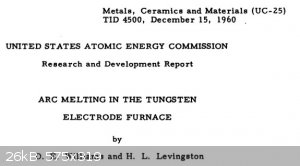 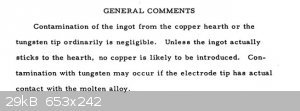
So, it looks like a non-consumable W electrode can work.
[Edited on 8-10-2014 by Dan Vizine]
|
|
|
bobm4360
Hazard to Self
 
Posts: 60
Registered: 18-4-2011
Location: On a wretched little island.
Member Is Offline
Mood: No Mood
|
|
Here's the report.
Regards,
Bob
Attachment: IS-262.pdf (1.5MB)
This file has been downloaded 575 times
|
|
|
Dan Vizine
National Hazard
   
Posts: 628
Registered: 4-4-2014
Location: Tonawanda, New York
Member Is Offline
Mood: High Resistance
|
|
Hi Bob,
Very grateful for the reference.
Thanks,
Dan
|
|
|
phlogiston
International Hazard
    
Posts: 1379
Registered: 26-4-2008
Location: Neon Thorium Erbium Lanthanum Neodymium Sulphur
Member Is Offline
Mood: pyrophoric
|
|
On the contrary, it is refreshing and very stimulating to see someone plan his experiments very carefully, considering every potential problem and
devicing a solution.
This is a great thread! thank alot for sharing your efforts, including the details of your considerations and preparing your setup.
-----
"If a rocket goes up, who cares where it comes down, that's not my concern said Wernher von Braun" - Tom Lehrer |
|
|
Dan Vizine
National Hazard
   
Posts: 628
Registered: 4-4-2014
Location: Tonawanda, New York
Member Is Offline
Mood: High Resistance
|
|
In light of the below conversation, I purchased a sheet of 309 SS and a new reactor will be constructed.
**********************************************************
Yesterday I contacted a British SS firm to ask about the suggested material of construction to stand up to molten Ca/CaCl2 at 1050 C for 5 hours.
Today, I received this reply from their resident metals expert. This is in relation to my ongoing calciothermic reduction of ThO2 project.
Interestingly, SS 446 is what the original Sylvania researchers used...
"The combination of molten calcium and calcium chloride salt is a difficult combination for most materials. Molten calcium can cause cracking of RA330
and nickel based alloys. On the other hand calcium chloride molten salts in the presence of oxygen fluxes the scale eating away at the chromium oxide
coating. In these applications RA330 or 600 are alloys of choice. Since you have both, you now need a compromise, If the temperature were lower, 309
would be a good choice, but at 1050 C, you are above the oxidation limit. RA 253 MA could be a reasonable compromise, given the sublayer of silica and
RA330 is the only other potential compromise. Keep in mind that the oxidation limit of RA 253 MA is 1090, a temperature surge that takes the metal
above this temperature, could have adverse affects of RA 253 MA, in terms of breakdown of the oxide and leaching. RA 253 MA also has better creep
strength at this temperature. So the question is just how well can you control the temperature of the metal of construction. Regardless of the
material, there is not certainty that either will work, only the possibility. The 446 that you mention has not strength or ductility at this
temperature. I am attaching an article on materials for salt bath construction. Pay close attention to the comments on properly maintaining the salt
as the maintenance is the key to attaining a reasonable life."
Attachment: SALT POTS.pdf (308kB)
This file has been downloaded 7 times
I replied as follows:
Thank you for your detailed answer. I was aware that molten Ca was aggressive toward Ni based alloys, hence the worry that the 304 SS bomb that I have
may not work.
I’m attempting to duplicate work performed by Sylvania researchers 50+ years ago. They employed 446 for the bomb reactor. I was hoping a more
accessible alloy might work well enough. If I can maintain the level of leached metallic impurities below 1 % I would be happy. I plan to have the
product powder vacuum arc re-melted to give beads, which I understand will sometimes actually improve purity slightly.
-
Here are a few more details: A metal oxide (ThO2) was combined with Ca + CaCl2 in a SS 446 bomb. The bomb was heated in a furnace while being
maintained at 1050 C under an atmosphere of UHP argon supplied at a continual pressure (via external pipe) of 5 in Hg.
I assumed that the protective oxide on the bomb interior would be destroyed quickly by these strenuously reducing conditions and couldn’t be counted
on to provide any protection whatsoever. The oxide would, of course, protect the outside somewhat. Is this assumption wrong?
Would being above the oxidation temperature of SS 309 matter under these circumstances? Oxidation will only attack the outside of the bomb and past
experience in metal melting in SS 304 has shown that despite heavy scale formation, the 304 metal will maintain structural integrity over many melts
of copper and brass. So my concern really centers on the question of what effect will be felt by the bomb interior from this Ca/CaCl2 mixture over the
projected 2 heating cycles. I plan two 5 hour runs.
Upon re-visiting the different papers that I have gathered regarding the reduction, I realize that I quoted the wrong conditions.
Both of these variants worked:
1) 5 hours at 950 C
OR
2) 1 hour at 1050 C.
Does a 950 C reaction temp bode any better for my existing reactor of 1/8 “ SS 304?
My temperature control should be sufficiently good that I can keep things at desired temperature +/- 10 C. The reduction of ThO2 is barely exothermic
and so it shouldn’t be a big factor. The original workers didn’t even mention one.
And lastly, even though the Th raises eyebrows, this is obviously not a “terrorist” type project. If I were planning something nasty, the powdery
ThO2 that I have already would be the material of choice. I want to turn this into small beads of metal for sale to element collectors, thorium being
one of the hardest samples to obtain. I have a deadline, too. After Jan 1, 2015 I won’t be able to sell without a license in the US and this is just
a basement project by a retired chemist.
And the answer I received:
Dan:
The 950 C temperature is still well above the limit of 304 SS. However, at the 950 temperature, 309 stainless would be a reasonable alternative that
could withstand both of these conditions. 446 is a ferritic stainless steel and will be hard to find, as quality ferritic stainless steels are not
being produced in the US anymore unless one is willing to buy a full heat quantity.
So, the news is mixed (for me anyway). SS 309 can be found but I will need to construct a whole new reactor from it.
"All Your Children Are Poor Unfortunate Victims of Lies You Believe, a Plague Upon Your Ignorance that Keeps the Youth from the Truth They
Deserve"...F. Zappa
|
|
|
Dan Vizine
National Hazard
   
Posts: 628
Registered: 4-4-2014
Location: Tonawanda, New York
Member Is Offline
Mood: High Resistance
|
|
Wait.......
Did he think the molten salt was on the outside?!
I don't think we were talking about the same thing....
"All Your Children Are Poor Unfortunate Victims of Lies You Believe, a Plague Upon Your Ignorance that Keeps the Youth from the Truth They
Deserve"...F. Zappa
|
|
|
blogfast25
International Hazard
    
Posts: 10562
Registered: 3-2-2008
Location: Neverland
Member Is Offline
Mood: No Mood
|
|
Reading his reply I don't get that impression.
|
|
|
Dan Vizine
National Hazard
   
Posts: 628
Registered: 4-4-2014
Location: Tonawanda, New York
Member Is Offline
Mood: High Resistance
|
|
The SS 309 plate arrived. I just finished cutting and forming the pieces. This is a roomy reactor, 1.9 inches ID x 3.9 inches tall (interior), ~ 11
cubic inches, about 180 mL. I decided that I'd get it professionally welded for safety reasons. Full penetration TIG welds with SS 309 wire.
The first shop that I called turned me down for liability reasons, but not the ones you might have guessed. It's because it's a vessel. Vessels are a
special subset of welded articles. You need special certs. to do that kind of welding for hire because of the obvious reason...vessels shouldn't fail
because of the extreme danger some failures could cause, say a propane tank, for example.
But the second shop was more accommodating. When the female 1/2" SS coupling gets here, he'll do it for maybe $50.
So, here it is, forming was done on a hydraulic press around a 2" diameter cylindrical steel form. The edges to be joined take a bit of a beating
during forming, so everything was trued up on a horizontal metal-cutting band saw by slicing away the damaged edges, which is why the cylinder is just
below round numbers in dimensions. This gives pieces which fit together very well.
The project keeps inching along at glacial speed.
I think this was the last major hurtle. The title of this thread is more and more apropos by the day.
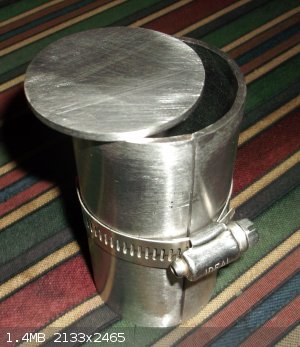
edit~
I was just thinking about agitation. I wonder if a few maybe 1/4" dia. tantalum balls would be beneficial to add for stirring? It's tough to guess. Is
the acceleration and length of the arc it moves through enough to cause the beads to plow through the starting thorium dioxide and, later, through
the Th metal powder?
There is probably (high probability) no downside, I guess, other than potentially wasted time and Ta. Ta likely has very low solubility in thorium,
probably 50 - 100 less than the Fe in the reactor, so it shouldn't cause a contamination issue.
[Edited on 6-11-2014 by Dan Vizine]
"All Your Children Are Poor Unfortunate Victims of Lies You Believe, a Plague Upon Your Ignorance that Keeps the Youth from the Truth They
Deserve"...F. Zappa
|
|
|
phlogiston
International Hazard
    
Posts: 1379
Registered: 26-4-2008
Location: Neon Thorium Erbium Lanthanum Neodymium Sulphur
Member Is Offline
Mood: pyrophoric
|
|
That's beautiful.
Given that the atomic radii of tantalum and iron are similar (145 pm and 140 pm respectively), why do you predict Ta is not likely to be also somewhat
soluble in Th?
Do you intend to rotate/shake the reactor to move the Ta balls around, or would you add them in addition to the stirrer you made in september?
Impressive work, love reading it, thanks.
[Edited on 6-11-2014 by phlogiston]
-----
"If a rocket goes up, who cares where it comes down, that's not my concern said Wernher von Braun" - Tom Lehrer |
|
|
Dan Vizine
National Hazard
   
Posts: 628
Registered: 4-4-2014
Location: Tonawanda, New York
Member Is Offline
Mood: High Resistance
|
|
Oops...my bad. The thorium won't be molten at any point.
"Ta likely has very low solubility in thorium, probably 50 - 100 less than the Fe...."
Should have read:
"Ta likely has very low solubility in calcium, probably 50 - 100 less than the Fe...."
It's often said that final product purity depends mostly on the purity of reactants in these direct oxide reductions, and anything found in or
dissolved in the Ca largely ends up in the thorium.
I'd just add them to the reaction mixture and let them roll around as the reactor moves like a "standard" washing machine agitator does.
Thanks for the kind words, I'm happy that you enjoy it!
[Edited on 6-11-2014 by Dan Vizine]
"All Your Children Are Poor Unfortunate Victims of Lies You Believe, a Plague Upon Your Ignorance that Keeps the Youth from the Truth They
Deserve"...F. Zappa
|
|
|
Arcuritech
Harmless

Posts: 34
Registered: 19-8-2012
Location: Scraping fused boria from a crucible.
Member Is Offline
|
|
As far as melting the thorium goes, why not use an induction heater? They don't use them industrially because of scaling problems but on the home
scale it seem perfectly workable. The best part is that this won't even involve direct contact - no need for HV feedthroughs into whatever you're
using as an inert environment.
"If we knew what we were doing, it wouldn't be called research." -Albert Einstein
"There are few things -- whether in the outward world, or, to a certain depth, in the invisible sphere of thought -- few things hidden from the man
who devotes himself earnestly and unreservedly to the solution of a mystery." -Nathaniel Hawthorne ("Roger Chillingworth")
|
|
|
Dan Vizine
National Hazard
   
Posts: 628
Registered: 4-4-2014
Location: Tonawanda, New York
Member Is Offline
Mood: High Resistance
|
|
The most successful bomb reductions were done exactly that way......in a refractory metal crucible, under a quartz bell jar and heated by induction.
It would be wonderful, got one to loan me?
Here is a collection of information about the distinct types of liquid metal attack on other metals.
Attachment: Types of liquid-metal corrosion attack .docx (741kB)
This file has been downloaded 519 times
"All Your Children Are Poor Unfortunate Victims of Lies You Believe, a Plague Upon Your Ignorance that Keeps the Youth from the Truth They
Deserve"...F. Zappa
|
|
|
Arcuritech
Harmless

Posts: 34
Registered: 19-8-2012
Location: Scraping fused boria from a crucible.
Member Is Offline
|
|
I don't have high power LC resonators to throw around but they are pretty easy to make as long as you aren't frightened by moderately high voltage
electricity.
"If we knew what we were doing, it wouldn't be called research." -Albert Einstein
"There are few things -- whether in the outward world, or, to a certain depth, in the invisible sphere of thought -- few things hidden from the man
who devotes himself earnestly and unreservedly to the solution of a mystery." -Nathaniel Hawthorne ("Roger Chillingworth")
|
|
|
froot
Hazard to Others
  
Posts: 347
Registered: 23-10-2003
Location: South Africa
Member Is Offline
Mood: refluxed
|
|
Some heat treatment companies use induction heating to case harden metal components, when you get to that point it may be worth calling up a few of
them and hopefully you find an obliging person to assist you. You would need to build your furnace setup with the induction coil in it which is
usually a copper tube fashioned into a coil with contact plates brazed onto it.
We salute the improvement of the human genome by honoring those who remove themselves from it.
Of necessity, this honor is generally bestowed posthumously. - www.darwinawards.com |
|
|
Dan Vizine
National Hazard
   
Posts: 628
Registered: 4-4-2014
Location: Tonawanda, New York
Member Is Offline
Mood: High Resistance
|
|
I have no reservations at all about high voltages, building control/power electronics was a hobby once. If not for the cost of the electronics, this
is something I'd have built long ago to support my metal-melting activities. But, the point is, once I built an induction heater, then what? Then, I'd
need to buy a Vycor bell jar or similar. Then, to take advantage of the improvements these offer, I'd be obliged to obtain a molybdenum crucible.
We're talking real time and money. It would be great, but not practical.
My approaches often come from having worked in synthesis all my life. One of the skills that you really come to prize is the ability to achieve good
results with the minimum practical outlay of effort and money while pushing your existing, or practically obtainable, equipment to the safe limit of
its performance. And hopefully innovating some things along the way. I've attempted to continue that discipline here. "Don't let the perfect be the
enemy of the good" is some of the best advice I've ever heard, given our finite nature.
On the technical side, I'd like to mention a few "fall-back" options that I do have, or maybe I should more accurately call them remediation steps.
The process of arc melting in vacuo is actually also a purification procedure. The crude Th powder will undoubtedly contain carbon,
chromium, nickel, iron, oxygen, calcium and other trace elements. The desired final product should be malleable. Inclusion of tiny amounts of
impurities can drastically harden the metal by blocking slip planes. Transition metal impurities will typically show up this way, although even gas
atoms can have this effect. Impurities that volatilize, with or without dissociation, at thorium's mp will be minimized unless they're
firmly bound, as for example, oxygen will be by thorium. A sign of good quality metal is fairly reliably indicated by the ability of the metal to
resist appreciable darkening in air. Excessive oxide causes the metal to darken quickly. Even the best thorium products typically have several tenths
of a per cent oxygen. Malleability will be the main yardstick of purity but it will be supplemented by oxidation resistance.
The next step would be used only if absolutely necessary and it is the "crystal bar" purification method using iodine as a carrier. It would give a
gorgeous product, but would involve so much development effort that I'd probably reprocess via the fluoride and reduce to metal again.
About a commercial assist...even if they could get past the "radioactive" part, you'd still need a nearly perfect blanket of UHP argon. My electric
furnace will maintain the required 950 C for 5 hours with absolutely no sweat and with my argon tank parked along side. Simple, straightforward....
[Edited on 12-11-2014 by Dan Vizine]
"All Your Children Are Poor Unfortunate Victims of Lies You Believe, a Plague Upon Your Ignorance that Keeps the Youth from the Truth They
Deserve"...F. Zappa
|
|
|
Dan Vizine
National Hazard
   
Posts: 628
Registered: 4-4-2014
Location: Tonawanda, New York
Member Is Offline
Mood: High Resistance
|
|
After 2+ weeks of waiting because of the welding company's busy schedule, another week when his [the welder's] "machine was being fixed" and more time
as he promised to get it done, but then didn't, I retrieved my un-welded parts, only to start looking for another welder. A big-time concern just down
the road, Goergen-Mackwirth Co., said they'd do it for around $200.00. As I said, the hunt for a suitable shop continues. The first shop had quoted
$50 -60.
"All Your Children Are Poor Unfortunate Victims of Lies You Believe, a Plague Upon Your Ignorance that Keeps the Youth from the Truth They
Deserve"...F. Zappa
|
|
|
Dan Vizine
National Hazard
   
Posts: 628
Registered: 4-4-2014
Location: Tonawanda, New York
Member Is Offline
Mood: High Resistance
|
|
Hmmm...traveling again. You'd think a trip across the Atlantic would be fun unless you knew you were headed for Saudi Arabia. Actually, Israel first.
Then into the middle ages.....
Wikitravel reports:
My Kingdom will survive only insofar as it remains a country difficult to access, where the foreigner will have no other aim, with his task
fulfilled, but to get out. -- King Abdul Aziz bin Saud, c. 1930
I see.....
Saudi Arabia has some of the most restrictive travel policies in the world, and advance visas are required for all
foreigners desiring to enter............ Nationals of Israel and those with evidence of visiting Israel will be denied visas,
although merely being Jewish in and of itself is not a disqualifying factor.
I don’t understand what this means. I’ll be coming from Israel. Which is very clear evidence of visiting Israel. But there are airlines that fly
from Israel to Saudi Arabia, so I'm completely confused. Or is that only for passengers transiting through Saudi Arabia, coming from Israel? Not for
those actually staying in Saudi Arabia? Not a single human answered my calls at any SA Consulate in NYC, Washington or Houston.
Also from Wikitravel:
Hepatitis and Meningitis vaccinations are required for general travel to the Kingdom. OK, not unreasonable..
Driving in Saudi Arabia is not regulated and rules are not followed, thus Saudi Arabia has the highest incidence of
car accident fatalities in the world. It is common to find drivers driving against the traffic on full speed. (Oh, and police officers often
decide accident responsibilities and punishments at the scene). Getting pretty weird now.....
Be careful of unregistered cars claiming to be taxis. If possible, always ride with a friend who knows the country. There
are no street addresses in Saudi Arabia, so you will have to know your route well, and pay attention to the road to explain to the driver where to
turn. How quaint and disturbing....
Malaria, Dengue fever and the new SARS-like Coronavirus (Middle Eastern Respiratory Syndrome - Coronavirus "MERS-CoV") are
major concerns when travelling to Saudi Arabia and all cause death if acquired. Public and private hospitals in Saudi Arabia, by law, do not
admit foreigners even with health insurance and during a life threatening emergency. What?!! Are you kidding me? Now, it would seem
they've crossed the line into institutionalized inhumanity.
Oh, and I'll be traveling to Osama Bin Laden's Alma Mater to work. Wonder if they have yearbooks? President of the chess club, maybe?
Most likely to be the hide and seek champion, 2001-2011?
The joys never end. At least I'm nowhere near Yemen (you know they're all half-crazy, right?).
All western joys are forbidden, except to the wealthy, who can flaunt the laws.
The King was truly prophetic in his words, I can't wait to get in and back out again as soon as humanly possible. If there's a flight I can catch
after work, no matter what time, I'm on it and gone forever.
Israel might be interesting if I were religious, and so it won't be in the slightest. Two exotic countries without a shred of interest. In Israel,
Nazareth is down the road a bit, be it city or band, not interested.
Oh yeah, almost forgot the cherry in Saudi Arabia...According to a 2014 poll, King Abdulaziz International Airport was voted as the second worst
airport in the world. And, did I mention that the mosques will sound off at 5 AM? Gives you at least an hour to lay there and think of how badly you
don't want to be there.
If you don't hear from me again, it'll probably be because I expressed a true opinion and was jailed. You DON'T insult the government, actually "The
House of Saud".
Just more delays in the work I want to do.
[Edited on 16-1-2015 by Dan Vizine]
"All Your Children Are Poor Unfortunate Victims of Lies You Believe, a Plague Upon Your Ignorance that Keeps the Youth from the Truth They
Deserve"...F. Zappa
|
|
|
Dan Vizine
National Hazard
   
Posts: 628
Registered: 4-4-2014
Location: Tonawanda, New York
Member Is Offline
Mood: High Resistance
|
|
Saudi Arabian trip otherwise accomplished, Israeli trip still on.
Meanwhile, I can't believe how hard it is to find somebody who will do 10 inches of MIG/TIG welding for less than $200 plus. That's damn near the cost
of a entry level MIG.
I just found out that the person who I was counting on to do the vacuum arc remelting, misunderstood the nature of the material to be melted. He won't
do it. That leaves hydraulic compaction as the only available option left to me.
I wish I had some actual science to report on, I know this is not particularly interesting reading. Oh, for a good laugh you could head over to my
Barium enema, excuse me, that's animus thread to see how barium is kicking my ass.
"All Your Children Are Poor Unfortunate Victims of Lies You Believe, a Plague Upon Your Ignorance that Keeps the Youth from the Truth They
Deserve"...F. Zappa
|
|
|
Chemosynthesis
International Hazard
    
Posts: 1071
Registered: 26-9-2013
Member Is Offline
Mood: No Mood
|
|
I hope you have some entertaining stories (or perhaps videos) from your travels.
As for welding, I am sorry to hear. I met a master welder recently, and it's really fascinating to see how they can bill.
|
|
|
| Pages:
1
..
3
4
5
6
7
..
9 |
|